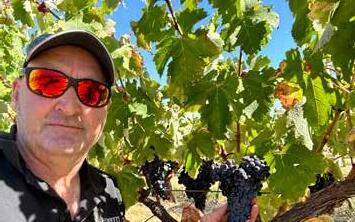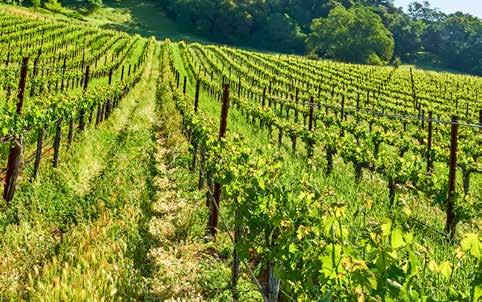
AUTUMN
• Is TCA in the air a threat for bottled wine?
• Climate change consequences for Pinot Noir berry quality
• Managing wine portfolios for growth
• Tasting: Reduced and No & Low Alcohol Still White Wines





INDUSTRY ASSOCIATION COLUMNS
8 WINE AUSTRALIA (Martin Cole): Driving growth through products that meet consumer demands
9 AGW (Lee McLean): There’s never been a more important time for governments to invest in the wine industry
10 ASVO (Andy Clarke): Post-vintage events ripe for the picking
WINEMAKING
12 The influence of mushroom chitosan on caftaric acid and furan-derived aroma compounds in Pinot Noir juice and base wine
21 Is TCA in the air a threat for bottled wine?
33 AWRI REPORT: NOLO wine — laying the groundwork for big steps forward
VITICULTURE
30 Cover crops and no-tillage show negligible effects on grapevine physiology in warm and hot climates
45 Performance of genetically diverse phylloxera genotypes on 5C Teleki rootstock
52 TONY HOARE: Managing vineyards in heatwaves – Part 1
56 Turning up the heat: climate change consequences for Pinot Noir berry quality
60 Grapevine trunk disease pathogen spore detection varies within and around vineyards
66 The latest research on grapevine virology: Highlights of the 20th International Council for the Study of Virus and Viruslike Diseases of the Grapevine meeting
71 ALTERNATIVE VARIETIES: Counoise
BUSINESS & MARKETING
73 Rebalancing Australian wine supply and demand remains a challenge despite small reduction in wine inventory in 2022-23
75 Managing wine product portfolios for growth
77 Which are Australia’s emerging winegrape varieties?
TASTING
86 Reduced and no and low alcohol still white wines
Kym Anderson
Matthew Ayres
Regina Billones-
Baaijens
Bernedette
Carmody
Andy Clarke
Catherine Clarke
Justin Cohen
Martin Cole
John Paul
Cunningham
Peter Dry
Scott Gregan
Nuredin Habili
Sandy Hathaway
Jessica Henneken
Tony Hoare
Belinda Hughes
Brian Jordan Rainer Jung
Belinda Kemp
Mark Krstic
S. Kaan Kurtural
Meifang Liu
Lauren Marigliano
Jacob Medeiros
Lee McLean
Judit Monis
Romy Moukarzel
Amber Parker
Wes Pearson
Gary Pickering
Germán Puga
Sandra Savocchia
Olaf Schelezki
Duncan Shouler
Mark Sosnowski
Justin Tanner
Andrii Tarasov
Nazereth Torres
Shufen Xu
Runze Yu
Daniele Zaccaria
Maria Zumkeller
It’s been quite the start to the New Year for the Australian wine industry.
First, there was the release in early January of the long-anticipated draft of the One Grape & Wine Sector Plan — the document designed to outline what the industry needs to prioritise between now and 2030 to address its near and present challenges.
And then came the news just as this issue of the Wine & Viticulture Journal was being finalised for print in late March that China had decided to remove the anti-dumping duties it imposed on Australian wine in March 2021 for what was supposed to be five years.
Suffice to say, the draft One Grape & Wine Sector Plan, which the boards of Australian Grape & Wine (AGW) and Wine Australia (WA) identified a need for in September 2022 and was based on sector-wide consultation which ran from July to October 2023, was met with largely unfavourable reactions from members and observers of the wine industry.
Ross Brown, executive director of the Brown Family Wine Group, said his company expected the document to have a “strategic focus with measurable and actional outcomes”. Instead, he said it “lacks strategy and doesn’t define clear actions for the industry” and presented “nothing bold or substantially different to the status quo”. Andrew Weeks, former chief executive of Australian Vignerons (which merged with the Winemakers’ Federation of Australia in 2019 to become Australian Grape & Wine), lamented the fact that the plan has “no clear articulation of the key problems that the wine sector is facing” and “has limited chance of success”. Even the Australian Wine Research Institute, which curiously failed to rate a mention in the draft plan’s list of ‘sector bodies supporting the success of the grape and wine sector’, described it as “a plan to plan” in its formal submission in response to the plan.

After the feedback period to the plan ended on 5 February, AGW and WA, the organisations that have been leading the development of the plan, wrote to industry and noted that “most respondents raised the need to better define the plan’s next steps”. While confirming that the plan aims to “highlight the collective priorities identified by the grape and wine sector to encourage greater alignment of activity across the industry” it was not “a prescriptive plan”. “It will be up to each organisation, including representative organisations and individual businesses, to assess the plan and set their own targets.”
AGW and Wine Australia, with the assistance of consulting firm ACIL Allen, are now in the process of “refining and enhancing” the plan to “reshape the final document” which is scheduled for release mid-year.
The One Grape & Wine Sector Plan is being developed in response to “unprecedented challenges” impacting the industry. China’s decision to impose antidumping duties on Australian bottled wine was one of those challenges. After peaking at $1.3 billion in the 12 months ended October 2020, Australian wine exports to China totalled just $10.1 million in the 12 months ended December 2023. And to think the tariffs had two years to run until AGW convinced China in November last year to review the need for the duties!
According to statistics from Trade Data Monitor, total wine imports to China fell from 688 million litres in 2018 to 248 million litres in 2023 – a third of what it was five years ago. Clearly, Australian wine is highly unlikely to enjoy the peaks it once did anytime soon, but it’s a welcome win nonetheless. Even China is hoping that having our products back in the marketplace will provide some much-needed competition to alleviate the rising prices of its existing imported wines and stimulate the overall domestic demand for wine, including its own home-grown products.
INDUSTRY OUTLOOK
TASKFORCE FORMED TO ADDRESS INDUSTRY CHALLENGES
Commonwealth, state and territory agriculture ministers agreed to establish a viticulture and wine sector working group following an agriculture ministers’ meeting on 8 March.
The formation of the working group was in response to “the significant challenges facing winegrape growers, particularly in the inland regions”, a communique of the meeting revealed.
The working group will comprise representatives of the Commonwealth, state and territory governments, Wine Australia, Australian Grape and Wine and other relevant groups as agreed by the working group, “to provide recommendations to Agriculture Ministers to address the challenges facing growers”, particularly the current oversupply of red winegrapes.
The working group was expected to visit regions most impacted by the oversupply, including the Riverland in SA and the Riverina in NSW, reporting back to agriculture ministers by the end of April 2024.
“The working group will also propose to agriculture ministers actions to support improvement in the grape and wine sector and its long-term viability by July,” the communique said.
Australian Grape & Wine (AGW) welcomed the formation of the work group.
“Australian Grape & Wine has been encouraging a coordinated and collaborative approach to deal with the challenges our sector is facing and we are pleased Ministers have agreed to form this working group,” said AGW chief executive Lee McLean.
“We know there are a number of regions experiencing acute financial pressure as a result of supply and demand imbalances, including the Riverland in South Australia, the Riverina in NSW, and the Murray Valley in Victoria, and it’s pleasing the group will focus on ways we can work together to relieve these pressures in these regions,” he said.
“Australian Grape & Wine has put a range of options to the Albanese Government ahead of the Federal Budget, including proposals to help rebalance supply, grow demand and boost regional tourism. These proposals are all aimed at helping Australia’s grapegrowers and winemakers to find a pathway through the current
challenges towards a sustainable and more profitable future.”
Lee said the formation of the working group was a reflection of the strong working relationship that AGW had developed with the Australian Government.
INDUSTRY AWAITS FINALISED ONE SECTOR PLAN
The Australian wine industry is awaiting the release of the finalised One Grape & Wine Sector Plan following publication of the draft document in early January.
Developed jointly by Australian Grape & Wine (AGW) and Wine Australia (WA), the draft ‘One Sector Plan’ is aimed at directing the collective efforts of the industry in response to its recent challenges and to get the sector back on track to achieving the longterm goals set out in Vision 2050.
The draft plan was informed by sector-wide consultation which was carried out from July to October 2023.
Members of the wine industry were given until 5 February 2024 to provide feedback on the draft plan. AGW and WA subsequently advised that the views it received in response to the draft plan were “insightful and varied”.
“In light of your feedback, we are committed to refining and enhancing the One Grape & Wine Sector Plan to reflect the collective vision and aspirations of the industry. We intend to release the final One Grape & Wine Sector Plan mid-year,” said AGW chief executive Lee McLean and WA chief executive Martin Cole in an email to industry on 16 February.
“While the feedback received will be
considered as we reshape the final document, we note that most respondents raised the need to better define the plan’s next steps, and we would like to take the opportunity to respond to this now to explain our view of what the plan is designed to do and what it will be used for.
“Our objective for the One Grape and Wine Sector Plan is to help organisations and businesses to find opportunities to collaborate where they can for the common good of the industry, drawing upon the priorities grapegrowers, winemakers, representative organisations, research institutions and others have identified throughout the consultation process,” Cole and McLean said.
“This is not a prescriptive plan. It will be up to each organisation, including representative organisations and individual businesses, to assess the plan and set their own targets. This reflects the fact that while we should be united where we can, there will be areas in which our priorities will differ. It also reflects the individual governance arrangements that every organisation in the industry must abide by in crafting their own plans.”
The draft One Grape & Wine Sector Plan can be downloaded here: www.wineaustralia. com/whats-happening/one-sector-plan
WINE EXPORTS
CHINA REMOVES DUTIES ON AUSTRALIAN BOTTLED WINE
The duties on Australian bottled wine imports into Mainland China were removed from 29 March 2024 following a review of the duties by China’s Ministry of Commerce (MOFCOM).
MOFCOM determined that, “in view of the changes in the relevant wine market conditions in China, it is no longer necessary to impose anti-dumping duties and countervailing duties on imported relevant wines originating in Australia”.
In advising of its decision, MOFCOM noted that the quantity of wine imported from Australia had dropped sharply since the introduction of the anti-dumping duties in late March 2021 and the source of China’s wine imports had adjusted accordingly. During the same time, the local demand for domestic wine had declined due to various factors including the competition from different product categories.


